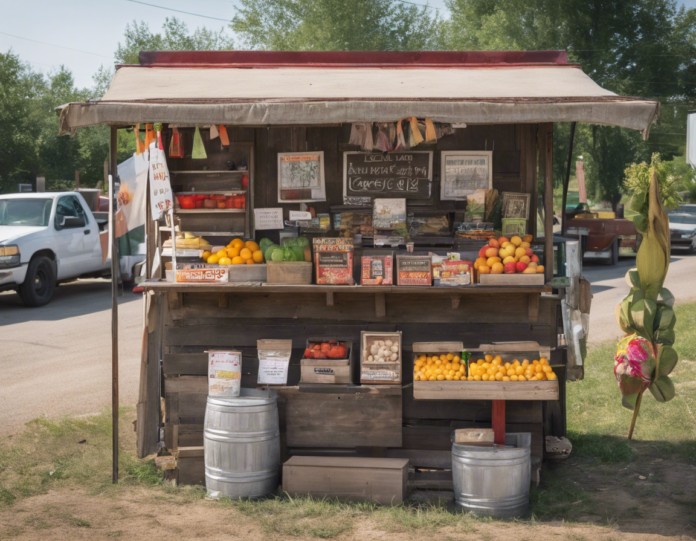Are you considering starting a roadside stand to sell your products but have questions about the process? Whether you’re planning to sell fruits and vegetables, flowers, handmade crafts, or any other goods, setting up a roadside stand can be a rewarding venture. In this comprehensive guide, we will address some common questions about roadside stands to help you navigate this business opportunity successfully.
What is a Roadside Stand?
A roadside stand is a small outdoor structure or area where farmers, artisans, or entrepreneurs display and sell their products directly to customers. These stands are typically located near roadsides or in high-traffic areas to attract passing motorists or pedestrians. Roadside stands are popular for selling fresh produce, plants, flowers, baked goods, crafts, and other locally made items.
How Do I Start a Roadside Stand?
Starting a roadside stand involves several steps:
-
Check Local Regulations: Before setting up your stand, research and comply with local regulations, zoning laws, permits, and health codes.
-
Choose a Location: Select a visible and easily accessible location with high foot or vehicle traffic.
-
Set Up Your Stand: Design an attractive display area or portable stand to showcase your products effectively.
-
Stock Your Stand: Ensure you have ample inventory of fresh produce, products, or crafts to sell.
-
Price Your Items: Determine competitive and fair prices for your goods to attract customers.
-
Market Your Stand: Advertise your roadside stand through signage, social media, word of mouth, or local promotions.
What Can I Sell at a Roadside Stand?
You can sell a variety of items at a roadside stand, including:
-
Fresh Produce: Fruits, vegetables, herbs, and farm-fresh products.
-
Plants and Flowers: Potted plants, flowers, shrubs, and garden decorations.
-
Baked Goods: Homemade pies, bread, cookies, cakes, and pastries.
-
Handmade Crafts: Artwork, jewelry, woodworking, textiles, and other artisanal products.
-
Canned Goods: Jams, jellies, preserves, pickles, sauces, and other homemade items.
How Can I Attract Customers to My Roadside Stand?
To attract customers to your roadside stand, consider the following strategies:
-
Eye-Catching Signage: Use colorful signs and banners to grab attention.
-
Fresh and Quality Products: Offer fresh, high-quality goods that appeal to customers.
-
Promotions and Deals: Provide discounts, package deals, or promotions to entice buyers.
-
Customer Service: Be friendly, approachable, and provide excellent customer service.
-
Social Media: Use social media platforms to promote your stand and engage with potential customers.
What Are the Benefits of Operating a Roadside Stand?
Running a roadside stand offers several advantages, including:
-
Direct Sales: Sell products directly to customers without intermediaries.
-
Low Overhead Costs: Minimal expenses compared to traditional storefronts.
-
Flexibility: Choose your hours of operation and adjust inventory based on demand.
-
Community Connection: Build relationships with local customers and become part of the community.
-
Profit Margins: Keep higher profit margins by eliminating distribution and retail markups.
How Do I Ensure Food Safety at My Roadside Stand?
If you’re selling food products at your roadside stand, it’s crucial to prioritize food safety. Here are some tips:
-
Proper Storage: Keep perishable items refrigerated or in coolers to maintain freshness.
-
Handwashing: Wash hands frequently and provide hand sanitizer for customers.
-
Clean Surfaces: Disinfect surfaces, utensils, and containers regularly.
-
Labeling: Clearly label products with ingredients, allergens, and expiration dates.
-
Hygiene Practices: Wear gloves, hairnets, or other appropriate gear when handling food.
Can I Sell Alcoholic Beverages at My Roadside Stand?
Selling alcoholic beverages at a roadside stand is subject to strict regulations and licensing requirements. In most regions, you would need a special permit or license to sell alcohol, and there may be restrictions on where and how you can sell such products. It’s essential to research and adhere to all laws and regulations governing the sale of alcoholic beverages in your area.
What Are Some Creative Display Ideas for a Roadside Stand?
Enhance the visual appeal of your roadside stand with these creative display ideas:
-
Seasonal Themes: Decorate your stand according to holidays or seasons.
-
Vertical Displays: Use shelves, crates, or racks to showcase products at varying heights.
-
Color Coordination: Arrange products by color for an aesthetically pleasing display.
-
Sample Stations: Offer samples of your products to encourage sales.
-
DIY Workshops: Host demonstrations or workshops showcasing how your products are made.
How Do I Handle Pricing and Payment at My Roadside Stand?
When it comes to pricing and payment at your roadside stand:
-
Pricing: Research competitors’ prices and consider factors like production costs, market demand, and profit margins when setting prices for your products.
-
Payment: Offer multiple payment options such as cash, credit/debit cards, mobile payments, or digital wallets to cater to diverse customer preferences.
What Are Some Tips for Successful Sales at a Roadside Stand?
To boost sales at your roadside stand, consider these tips:
-
Engage Customers: Interact with customers, offer product recommendations, and provide exceptional service.
-
Product Sampling: Provide free samples to entice customers to try your offerings.
-
Customer Incentives: Reward repeat customers with loyalty discounts or special promotions.
-
Cross-Selling: Suggest related products or bundles to increase the average transaction value.
-
Feedback Collection: Gather feedback from customers to improve products and services.
Conclusion
Running a roadside stand can be a fulfilling and profitable business endeavor. By understanding the key aspects of setting up and managing a roadside stand, you can effectively attract customers, drive sales, and build a loyal clientele. Remember to prioritize quality, customer service, and adherence to regulations to ensure the success of your roadside stand venture.
Frequently Asked Questions (FAQs)
- Do I Need a Permit to Operate a Roadside Stand?
-
Permit requirements vary by location. Check with your local authorities to determine if you need a permit for your roadside stand.
-
Can I Operate a Roadside Stand Year-Round?
-
Depending on the products you sell and weather conditions, you may choose to operate seasonally or year-round.
-
How Should I Price My Products at a Roadside Stand?
-
Consider factors like production costs, competitor prices, and target market when determining the pricing for your products.
-
What Marketing Strategies Are Effective for a Roadside Stand?
-
Utilize signage, social media, local events, collaborations, and word-of-mouth to market your roadside stand effectively.
-
Are There Restrictions on What I Can Sell at a Roadside Stand?
-
Some regions have restrictions on certain products like alcohol, tobacco, or homemade goods. Check local regulations for clarity.
-
How Can I Ensure Sustainability Practices at My Roadside Stand?
-
Implement practices like using eco-friendly packaging, sourcing locally, reducing waste, and promoting sustainability to attract environmentally conscious customers.
-
Can I Collaborate with Other Local Businesses at My Roadside Stand?
-
Partnering with local businesses for cross-promotions, joint events, or product collaborations can help attract a broader customer base and boost sales.
-
What Are the Benefits of Accepting Electronic Payments at a Roadside Stand?
-
Accepting electronic payments provides convenience to customers, increases sales opportunities, reduces the risk of handling cash, and enhances transaction security.
-
How Can I Differentiate My Roadside Stand from Competitors?
-
Focus on unique products, exceptional customer service, engaging displays, storytelling about your products or brand, and personalized experiences to stand out from competitors.
-
What Should I Do in Case of Inclement Weather at My Roadside Stand?
- Have a contingency plan for adverse weather conditions, such as setting up temporary covers, securing merchandise, or adjusting operating hours to ensure business continuity.

